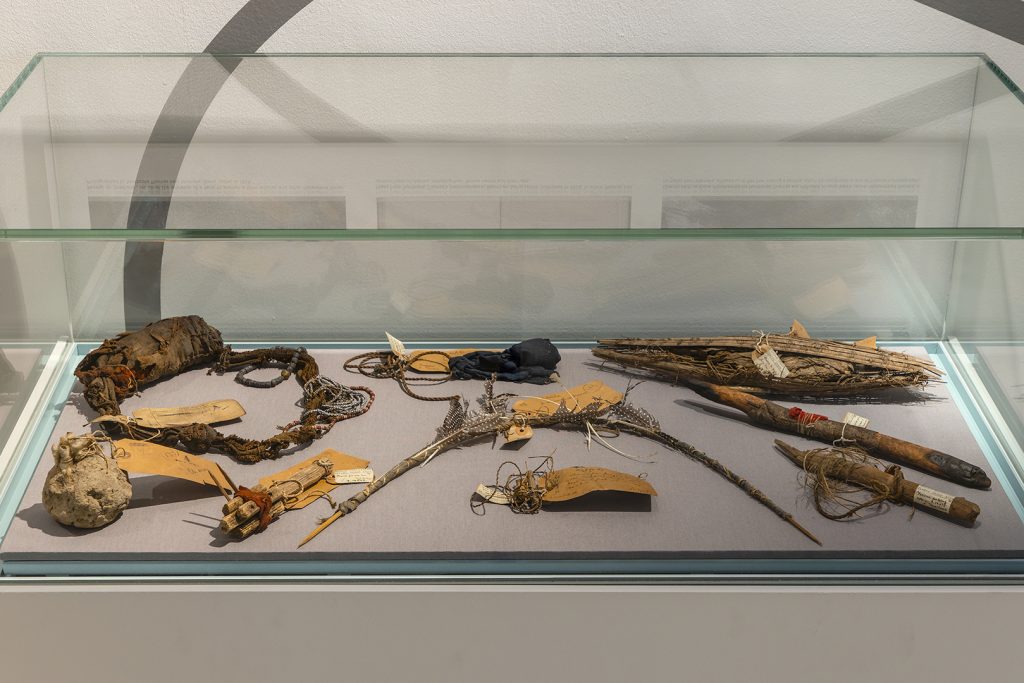
Sometimes the most potent objects are not the most visually striking. This is true of the various ‘sacrifices’ and ‘charms’ that Northcote Thomas collected in Sierra Leone in 1914-15, and now held by the University of Cambridge Museum of Archaeology and Anthropology. They take many forms – cloth covered bundles, a few sticks tied together, crumbling packages – yet they are also some of the most powerful objects in the Thomas collections. They have the power to protect people and their property from malevolent forces, including witchcraft, which might bring sickness, crop failure or other calamities.

Witchcraft and the various means to protect oneself from it appear to have been of particular interest to Thomas during his tour of mainly Temne-, Soso-, Koranko- and Limba-speaking communities in northern Sierra Leone. He devoted a number of chapters of his Anthropological Report on Sierra Leone to the topic and related matters. This reflects the centrality of the issue to the communities he worked with.
He evidently struggled to make sense of the numerous rites, ceremonies, sacrifices, amulets and charms that were employed by different communities to protect themselves from malevolent forces. This no doubt reflects the anthropologist’s desire to make distinctions between and classify the practices and objects he encountered. Thus, in Chapter 7 of his Report, Thomas discusses various rituals, sacrifices and magical things under categories of ‘satka’, ‘wanka’ and ‘kanta’, and yet in his descriptions the distinction between these is often blurred and confusing.

The ‘belief’ in witchcraft is still very much part of life in Sierra Leone and it is not unusual to see protective amulets, charms and other devices, especially in rural areas. The need to protect oneself from malevolent forces (the invisible ‘bullets’ of a ‘witchgun’, for example) is strongly felt and local herbalists or ritual specialists perform important roles in their communities. Although these charms are often constructed from ordinary things (basketwork, calabashes, eggs, stones, fishing nets), these have been ritually transformed. Thomas concluded that the objects were often selected because of their mimetic properties – a fragment of old fishing net thus becomes a ritual trap, for instance.

Satka are often set up outside people’s houses. They typically take the form of long poles, on top of which are suspended various things – sometimes a white or red cloth, sometimes a small fan or basket, sometimes a small bell. Thomas observed these too: ‘Chief among mimetic rites’, he wrote, ‘may be mentioned the custom of hanging up a fan which swings in the breeze and is believed to be efficacious in blowing away evil influences’ (Thomas 1916: 53). We were given a similar explanation at the village of Katumpeh, on the road between Kamalo and Kamakwie. Mr Abraham Dumbuya explained that his previous house was damaged by strong winds, so he had this satka made. Now when evil comes with the wind, it sees the satka and jumps over the house, leaving it unharmed. Instead, the satka welcomes in good luck. Another man in the same village explained that when his satka swings in the breeze, it will invite good luck to the household.

When we brought copies of Northcote Thomas’s photographs of Mamaka to show the present-day community, we asked about the various wanka he had photographed. One type, in particular, was instantly recognized. Thomas describes this as a type of ‘sacrifice’ ‘put at the entrance to a farm … to keep away witches, bad krifi [spirits], and evil-disposed persons and influences’ (Thomas 1916: 53).

In Mamaka, we were later introduced to Mohammed Kamara, a herbalist or omen, who agreed to let us film him making such a charm, which he described as a kantha. He explained that farmers would approach him to make the kantha. It would be set up at the entrance to a farm at the time of hoeing the soil, before planting. The kantha can be re-used from year to year, but a new ceremony must be performed each year. The kantha includes a raw egg wrapped first in a red cloth, then covered in a piece of old fishing net. These have previously been transformed into powerful things using herbs or medicines. These are placed in a basketry receptacle that has been woven into long strips of cane. The receptacle is then covered in another piece of red cloth and another piece of old fishing net, which is bound in place. Just like the example photographed by Northcote Thomas in 1914, this is then suspended on two poles and set up at the entrance of a farm. At key points in the making of the kantha, Mohammed spoke words that ‘activated’ the charm. The egg, he explained, was like a bomb – if a witch passed by, it would explode. The fishing net was a ritual trap.
Mohammed learnt the skills of a herbalist from his father, Pa Almamy Kamara, who had, in turn, learnt the art from his mother, Yanna Kanray. He explained that not everyone has the power to make such charms and cure diseases. One must be gifted with ‘four eyes’ – that is, the ability to engage with the spirit realm. We asked how much a farmer might pay him for a kantha and he explained that it depended on how much he was able to pay. We asked that the kantha Mohammed made for us be given to a poor farmer who could not afford to pay. We hope that it will protect his farm from harm and bring a good harvest!


